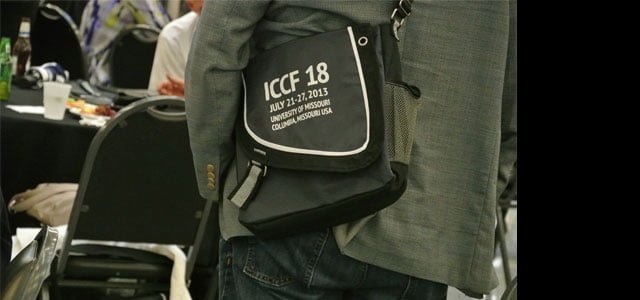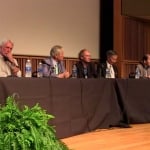I am now back from the above event after a long and circuitous drive home. Here are some of the thoughts I explored during the trip.
Without doubt the conference was wonderful in many respects, including both the opportunity to learn from the presented results of a variety of experimenters, and from seeing and talking with important, knowledgeable persons in the field, face to face. Nevertheless, I developed over the week a frustration that I finally voiced on the last day to the general assembly.
The last event of the conference was a panel discussion on what we can expect in the future: “The Way Forward” panel. Including the panel leader, there were seven persons sitting on the stage. The panel “discussion” proceeded by each of these seven individuals giving a 10 to 15 minute slideshow-supported presentation. The only exception was Mike McKubre who spoke for five minutes without a slideshow celebrating that the next ICCF will be held in Italy. He included in his remarks a criticism that too many people were revisiting past research and simply refining data to one more decimal point: “To move in ever diminishing circles doing the same thing others have done before won’t get us where we want to be.” His observations captured exactly the anxiety that I had been developing during the week.
I made as part of the question period after the panelists were done the following observations:
For this field to become commercially relevant, someone has to develop a system that will deliver:
1. Realistic amounts of power, e.g. 500-5000 W
2. At temperatures which are practical, e.g. 85°C; 150-200°C and, as a dream, 600-700°C, and
3. With coefficient of performance – COP values of at least 6, preferably 10 and possibly as high as 20 or more
In support, I observed that demonstrating milli-watts or even 2-digit watt outputs left this field in the category of a scientific curiosity. And producing even a megawatt of heat at a pathetic temperature level, such as 25°C, was virtually useless. (Perhaps it could be useful, for melting ice!) And finally, on the COP issue, I observed that it takes three barrels of oil to produce one barrel of electricity. Therefore a COP of 3 just breaks even on the electricity consumed. That’s why I set my floor value COP at 6.
There were two participants at the conference that showed commercial relevance. Robert Godes from Brillouin Corporation in California is working on a commercial boiler having nickel and palladium core operating at up to 2000 psi and 200°C. Also Brillouin Corp reports that they have a new Hot Tube model being tested at SRI that is expected to deliver steam at temperatures from 400ºC to 500ºC (750-932ºF). And Defkalion provided on July 23rd a live 9 hour Internet demonstration from Milan, Italy of their LENR technology.
This Defkalion webcast had an audience of around 1000 viewers online at its peak, including some 200 participants at ICCF-18. The Defkalion reactor was reported as providing water at 165.43ºC based on an input of 1858.8 Watts, and the heat output was 5721.6 Watts, giving a coefficient of performance (COP) of 3.1.
If these reports lead to commercial units, then these are the real champions of this year’s annual meeting.
There is still no theory about the effect. But those in the scientific community who whine about the lack of funding should realize that as long as they are producing only a teaspoon or toothpaste dab of unexplained excess energy, they will have to compete with all the vast numbers of other researchers who are lined-up to receive “blue sky” funds for their academic research. The “believers” who are chasing COP levels of 1.2 and 1.6 are hooked on the dream that someday, someone else will take their foundational research and turn it into a commercial reality. But after 24 years it’s time to get on with Part 2. If the three criteria that I have listed above are solidly met by anybody, there will be an avalanche of financial support from the commercial community. Who should receive this money? Why those who have demonstrated success, at a relevant level!
Yes, there is a Nobel Prize waiting out there for somebody who comes up with a theory that explains the effect. This is, indeed, a fascinating puzzle. And the sociology of the hunt for the answer to this puzzle will also be the basis of a number of PhD theses sometime in the future. Meanwhile, the researchers who are duplicating old experiments and ever higher levels of precision are not doing the field a good service, not unless they suddenly achieve a breakthrough in understanding. Such work is simply a demonstration of their competence in using laboratory equipment.
Before the conference I posted on ColdFusionNow a reference to the “Streetlight Effect“. I think this may have hit home with a few people; one of the presenters made an aside as he commenced to describe his 20 years of work in electrochemistry to the effect: “… notwithstanding that it might qualify as being limited to the vicinity of the streetlights”. When I made the original observation on the “Streetlight Effect” I had in mind the search for an explanation to the CF phenomenon. But having attended ICCF-18 I think there are enough favorable indications that practical applications can now be created even without having a rock-solid theory. So I suggest that henceforth the search beyond the range of the streetlights should be directed towards ratcheting-up performance in terms of the above the three criteria into the zone of commercial practicality.
If I were a rich venture capitalist looking to invest in this field, I would mine all the work that’s been done to date by undertaking a massive literature survey. There are people like Jed Rothwell, Jean-Paul Biberian and Ed Storms that know the existing literature pretty well. But they see it from their point of view. To make a breakthrough their knowledge has to be combined with the eager enthusiasm of newcomers who want to venture where others have not gone before.
What a combination if a highly energized core team of new, young and educated Cold Fusion enthusiasts can be combined with the resources and wisdom that have already been developed over the last 24 years! We may have such individuals available in the participants in the Martin Fleischmann Memorial Project. Now all that has to happen is for these enthusiasts to receive the support that will finally produce fruit from this long-struggling vine.



For this field to become commercially relevant, someone has to develop a system that will deliver:
1. Realistic amounts of power, e.g. 500-5000 W
2. At temperatures which are practical, e.g. 85°C; 150-200°C and, as a dream, 600-700°C, and
3. With coefficient of performance – COP values of at least 6, preferably 10 and possibly as high as 20 or more
I totally agree. According to Rossi, the American factory is already producing such LENR generators. If this is true (I believe it, but many people won’t without definitive proof), the mass media will seize on it, and the amount of money that will go into LENR R&D by risk adverse CEOs will be jaw dropping. In other words, once commercial viability of LENR has been demonstrated, the flood gates will open, and I predict that will occur very soon (predicated on the belief that Rossi is legit).
I agree with Brad. I do think Rossi’s 1 Mwatt E-cat (and hence the included 106 10 Kwatt e-cats) are real, and that they work! But the big mystery is why the single USA customer has not reported one single word about how it is doing and whether it is useful. A small bit of encouragement from them would really help.
And why has no company stepped up to accept the European offer of free installation and operation of an E-cat ?
“once commercial viability of LENR has been demonstrated, the flood gates will open, and I predict that will occur very soon (predicated on the belief that Rossi is legit).”
I agree.
As to theory explaining possible fusion of deuterium in palladium lattice look at the article. “Belgian LANR Patents” on e-Cat Site , Belgian patent BE1002780 translated into English in said article . It refers to “electrostatic wetting” explaining fusion by orbital broadening of protons in the presence of excess of electrons (electron sea) in palladium lattice. Lattice vibration may help to come to fusion. The transmutation of nickel into copper may be explained by the use of negative hydrogen (H-) anions formed by pottassium as catalyst (see the article “Cold Fusion Catalyst” on the e-Cat Site.
If I were a venture capitalist I would avoid the field. The minute lenr is described in a reproducible way the standing armies of scientists, technicians, managers, executives, support staff, and legal staff at the corporations and national laboratories will take over.
Yes, there is a Nobel Prize waiting out there for somebody who comes up with a theory that explains the effect.
———————————-
Just pick up any book on Nanopasmonics and you will be 90% there in understanding what LENR is all about.
The other 10% deals with Higgs theory.
LENR is hard to understand because Nanoplasmonics is hard to understand for anybody other than the electrochemists.
And Higgs theory is just too new for most to invest any time in really understanding it.